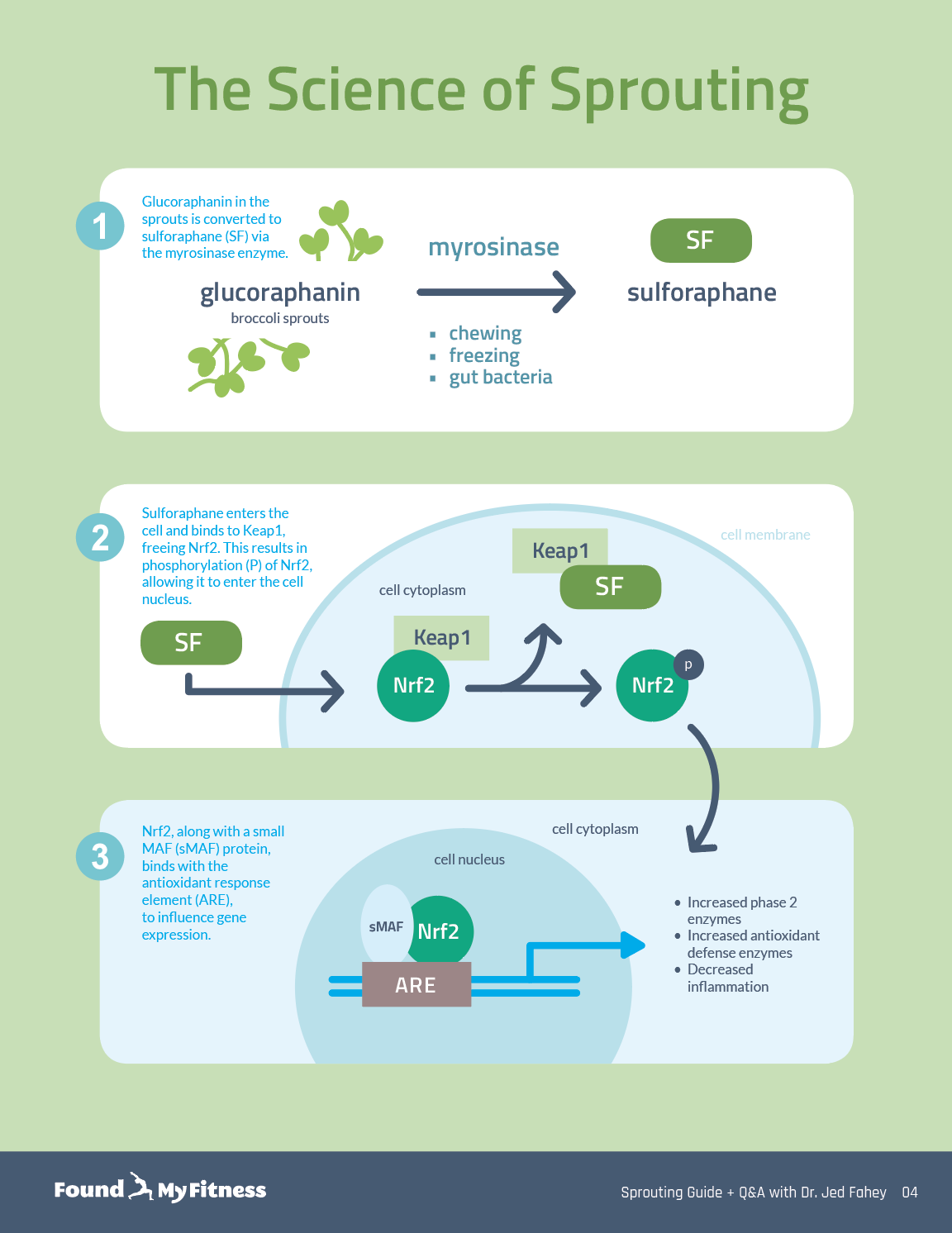How can you make broccoli sprouts more palatable? | Jed. Fahey
Enter your email to get our 15-page guide to sprouting broccoli and learn about the science of chemoprotective compount sulforaphane.
Broccoli sprouts are concentrated sources of sulforaphane, a type of isothiocyanate. Damaging broccoli sprouts – when chewing, chopping, or freezing – triggers an enzymatic reaction in the tiny plants that produces sulforaphane.

Get the full length version of this episode as a podcast.
This episode will make a great companion for a long drive.
Not everyone cares for broccoli sprouts' flavor, which is largely due to their glucosinolate content. Whereas the glucosinolates in some vegetables are notably bitter, those found in broccoli and broccoli sprouts are much milder. Attempts to disguise the flavor of the broccoli sprout teas used in clinical trials in China eventually resulted in a palatable beverage spiked with pineapple and lime. Children with autism required a more straightforward approach: supplementation. In this clip, Dr. Jed Fahey discusses strategies for disguising the flavor of broccoli sprouts.
[Dr. Patrick]: A sort of related question is people are sort of asking about the task of broccoli sprouts. For example, you know, if you do blend the sprouts together and drink it as I have done in the past, it's really not very pleasant tasting. I mean it's got, like, a spicy taste, I like spicy. So it's kind of got that wasabi kick, but not a lot of people like that. And there are some parents that are trying to give sulforaphane and/or broccoli sprouts in some form or another to their children, and autistic children who seem to be very picky eaters most of the time. Is there any recommendations for, like, making it better tasting in a smoothie, something that's not going to affect the bioavailability of sulforaphane?
[Dr. Fahey]: Yeah. So yeah, I think there are and I think they come from our...some of our clinical studies where we had to camouflage the taste or, you know, we had to incorporate broccoli sprouts into something that was palatable for more people.
I saw the smoothie question and my off-the-cuff response would be, hey, look at me, I come from a generation that didn't know smoothies were a food group. And, you know, they weren't part of my staple diet. Most...a lot of people in the younger generations, I think, think smoothies are a mandatory good food. I do take...I do eat, take, drink smoothies sometimes and it is a good...it is...it presents a good option to incorporate the vegetable, broccoli sprouts, and to disguise it or camouflage it with some other taste.
So a couple of ways to answer your question. When we did our trials in China, we had to come up with disguising mechanisms. And first we used mango juice. And this was a bunch of PhDs getting together and saying, "Whoa, how does this taste? How does this taste?" And we picked mango juice. We were all Americans doing this test in America and we're used to very sweet stuff in America. We took it to China where they're not...where the palates are not accustomed to such sweet taste and they didn't like it very much, our study subjects.
So we then did some rather extensive studies with a flavor analysis company, sensory analysis company in New Jersey. We actually published on this. And they helped us identify pineapple juice with a hint of lime juice in it, and you can even dilute it. What we did with our next China study was to dilute it one to one with water. And it turned out to be a really good disguiser of the taste, or complementor of the taste, of broccoli sprouts and it sort of...it takes your taste buds and your mind away from the taste which a lot of people don't find very pleasant.
In terms of the autism part of the question, in a number of the clinical trials we've done on autism we, of course, had to use...we didn't give them broccoli sprouts, that would have been way too difficult. And you're right, a lot of kids with autism, people with autism, have very, very rigid food preferences, and sometimes very narrow. But what we did is give them supplements with a calibrated amount of sulforaphane, and then we gave each of the parents just a $5-dollar Amazon hand pill crusher so they could crush the pill and add it to whatever the favorite food of that child was, in the case of the studies we did. So yeah, they wound up camouflaging both taste and texture.
- [Dr. Patrick]: That's a good idea.
A developmental disorder characterized by impaired social interaction, behavioral problems, and poor communication. Autism typically manifests in early childhood and is slightly more common among boys than girls. In clinical trials, sulforaphane, a compound derived from broccoli and broccoli sprouts, reduces the characteristic behaviors associated with autism.
The extent and rate at which drugs or other substances, such as plant-based dietary compounds, enter the body’s circulation. Bioavailability is influenced by a variety of factors, including dose, the presence of other foods or substances, and interindividual differences in metabolism due to gut absorptive surface and commensal microbial populations.
An essential mineral present in many foods. Iron participates in many physiological functions and is a critical component of hemoglobin. Iron deficiency can cause anemia, fatigue, shortness of breath, and heart arrhythmias.
Surface of one's tongue. Used to describe a person's taste preferences.
An isothiocyanate compound derived from cruciferous vegetables such as broccoli, cauliflower, and mustard. Sulforaphane is produced when the plant is damaged when attacked by insects or eaten by humans. It activates cytoprotective mechanisms within cells in a hormetic-type response. Sulforaphane has demonstrated beneficial effects against several chronic health conditions, including autism, cancer, cardiovascular disease, diabetes, and others.
Attend Monthly Q&As with Rhonda
Support our work

The FoundMyFitness Q&A happens monthly for premium members. Attend live or listen in our exclusive member-only podcast The Aliquot.
Sulforaphane News
- Broccoli seed extract with a sulforaphane precursor reduced common cold symptom days in healthy adults.
- Sulforaphane-rich broccoli sprout extract modestly lowers fasting blood sugar in some people with prediabetes, perhaps due to variations in gut microbiota and individual metabolic traits.
- Sulforaphane, derived from broccoli, activates Nrf2, mitigating age-related skin changes and boosting the antioxidant defense system in mice.
- Sulforaphane from broccoli sprouts shows promise in preventing Alzheimer's disease – boosting memory and enhancing mitochondrial function in mice.
- Breathwork enhances endogenous antioxidant enzyme activity to counter oxidative stress.






